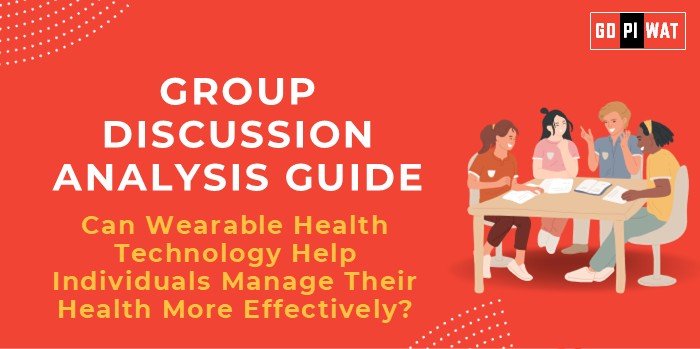📋 Group Discussion Analysis Guide: Can Wearable Health Technology Help Individuals Manage Their Health More Effectively?
🌐 Introduction to the Topic
Opening Context:
- 🕒 “In the era of advanced technology, wearable health devices, such as smartwatches, fitness trackers, and medical-grade wearables, have emerged as tools for proactive health management.”
- 📈 “Globally, the wearable technology market is projected to reach $150 billion by 2028, signaling its growing significance.”
Topic Background:
Wearable technology combines advancements in sensors, connectivity, and data analytics to monitor and improve health outcomes. From counting steps to tracking vital signs, such as heart rate and blood oxygen levels, these devices aim to empower users by providing real-time data. Initiatives like Apple’s Heart Study highlight how wearables can contribute to preventive healthcare.
📊 Quick Facts and Key Statistics
- 🌍 Market Size: Projected $150 billion by 2028 (Markets and Markets).
- 👥 Adoption: 1 in 5 adults in the U.S. uses wearable health devices (Pew Research).
- 📏 Accuracy: Devices like Fitbit achieve up to 90% accuracy in activity tracking.
- 🏥 Chronic Disease Management: Wearables reduce hospital visits for 30% of users managing chronic illnesses.
👥 Stakeholders and Their Roles
- 💻 Technology Companies: Innovate devices and apps for enhanced usability and data insights.
- 🩺 Healthcare Providers: Leverage wearable data for preventive care and remote monitoring.
- 🏛️ Governments: Regulate privacy standards and subsidize health-tech adoption.
- 🧍 Consumers: Actively use wearables for improved lifestyle and health management.
🏆 Achievements and Challenges
✨ Achievements:
- ✅ Improved Health Awareness: Real-time tracking helps users maintain healthy habits.
- 📊 Chronic Disease Monitoring: Devices like the Abbott Freestyle Libre empower diabetics with continuous glucose monitoring.
- 💸 Reduced Healthcare Costs: Preventive monitoring reduces emergency interventions by 15-20%.
⚠️ Challenges:
- 🔓 Data Privacy Concerns: Breaches like Fitbit’s security issues highlight risks.
- 📉 Accuracy Limitations: Inconsistencies in heart rate and calorie measurements may mislead users.
- 💵 Adoption Barriers: High costs and limited digital literacy hinder global penetration.
🌍 Global Comparisons:
- 🇺🇸 U.S.: Wearables integrated into employee wellness programs; 25% penetration.
- 🇯🇵 Japan: Pioneering in senior citizen health management via IoT and wearables.
💬 Structured Arguments for Discussion
- ✔️ Supporting Stance: “Wearables provide actionable insights that empower users to make healthier choices, reducing healthcare burdens.”
- ❌ Opposing Stance: “Issues like data inaccuracy and privacy concerns outweigh the benefits, creating skepticism about their efficacy.”
- 🔄 Balanced Perspective: “While wearables hold great potential, their true impact depends on addressing privacy, accessibility, and accuracy challenges.”
🎯 Effective Discussion Approaches
🚀 Opening Approaches:
- 📊 Data-driven Opening: “Wearable tech adoption has surged, with a market valuation of $150 billion by 2028.”
- ⚖️ Contrast Approach: “Despite their potential, wearables face hurdles in data reliability and user engagement.”
💡 Counter-Argument Handling:
- 📏 Data Accuracy: Acknowledge issues but highlight improvements, e.g., AI-driven wearables enhance precision.
- 🔒 Privacy: Propose solutions like end-to-end encryption and user consent mechanisms.
🔍 Strategic Analysis of Strengths and Weaknesses
- 💪 Strengths: Health awareness, chronic disease support, cost reduction.
- ⚖️ Weaknesses: Data inaccuracies, high costs, privacy risks.
- 🌱 Opportunities: Integration with AI, telemedicine growth, global expansion.
- ⚠️ Threats: Regulatory hurdles, cybersecurity risks, market competition.
🎓 Connecting with B-School Applications
🌐 Real-World Applications:
- 📈 Strategic product positioning in the health-tech market.
🤔 Sample Interview Questions:
- ❓ “How can wearable technology transform healthcare delivery?”
- ❓ “What are the key challenges wearable technology firms face today?”
💡 Insights for B-School Students:
- 🔍 Explore market entry strategies for wearable tech firms.
- 📊 Analyze the ethical implications of data collection and usage.


